

Quick Game-The best casual game center which you don't need to download any app! [Interview Highlights] Matsue Chiba & Soichiro Chiba, Shouaihiyashizome (indigo dye) craftspeople – THE DORAYAKI PROJECT. At first, Matsue and Soichiro (Matsue’s son) were reluctant to let me meet them, visit their workshop and carry out an interview.
![[Interview Highlights] Matsue Chiba & Soichiro Chiba, Shouaihiyashizome (indigo dye) craftspeople – THE DORAYAKI PROJECT](http://cdn.pearltrees.com/s/pic/th/shouaihiyashizome-craftspeople-191898291)
Now that I know more about them and about their work, I do understand: this is the most stressful time of the year for Shouaihiyashizome (indigo dye). If this step does not work as planned, the color will not come out properly and will not stick onto the fabric. Therefore, all work and effort made during the whole year would be vain. Let’s jump in the blue, blue dye. Commitment Unlike many other craftspeople I previously met, Matsue and Soichiro do not depend on Shouaihiyashizome to make a living. [Interview Highlights] Matsue Chiba & Soichiro Chiba, Shouaihiyashizome (indigo dye) craftspeople – THE DORAYAKI PROJECT. Le dictionnaire de la soie: Découvrir son histoire de ses origines jusqu’à ... - Jean-Jacques Boucher.
Sendai Traditional Crafts Te to Te to Te. Beautiful natural indigo dying inherited from woman to woman for generations Shouaihiyashizome has been passed from generation to generation in the Chiba family.
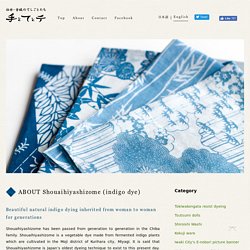
Shouaihiyashizome is a vegetable dye made from fermented indigo plants which are cultivated in the Moji district of Kurihara city, Miyagi. It is said that Shouaihiyashizome is Japan’s oldest dyeing technique to exist to this present day. This dyeing technique was originally introduced from China to Japan. Shouaihiyashizome flourished in Japan and popularity of this dyeing technique quickly spread. By the cultural assets registration is “Shouaizome”. TECHNIQUES – Les Hautes Étoffes. L'une des nombreuses techniques de teinture en provenance de Chine est la teinture au pochoir, ou Katazome, toujours connue et utilisée au Japon Le mot Katazome vient de deux mots japonais, kata, qui veut dire pochoir et some, qui veut dire teinture.
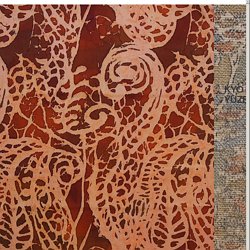
Le katazome est le procédé qui consiste à teindre le tissu en employant une pâte soluble appliquée sur le tissu à travers un pochoir découpé. Dutchman keeps paper-making traditions alive at his Shikoku studio. Rogier Uitenboogaart, who has been charmed by the world of washi (traditional Japanese paper) for the past three decades — especially its deep relationship with nature and people’s everyday lives — is trying to help preserve both nature and the traditional craft in this country.

“I’m enchanted by the abundance of nature in this country and the power that art and crafts have in keeping this abundant nature alive,” he said. Uitenboogaart lives deep inside the forests of Yusuhara, near the Shimanto River, in Kochi Prefecture. There, he grows his own plants, and makes washi by using them and spring water taken from the river. He grows five different types of kozo (paper mulberry) and mitsumata (oriental paper bush) — all without pesticides or fertilizer — to make washi. Examining Japan's traditional paper trail. Early January in Japan is a time for resting and staying cosy.

With falling temperatures, people like nothing more than diving under a kotatsu (heated table), visiting an onsen (hot spring) or tucking into a warming nabe hot pot, particularly following the busy new year festivities. For some 200 households, however, it’s a time for tough, manual work in unforgivingly cold conditions. Across the country, washi makers are entering their peak production season. Most will aim to make as much as possible during this month and next, to deliver what they believe is washi of the best possible strength, durability and shine.
It’s a practice that craftsmen say is proven by history; in ancient times, washi was solely a winter activity and the high-quality materials produced have survived for thousands of years. The answer lies in science. As washi-making is dependent on nature, it is deeply spiritual as well. Paying homage is vital as washi has long been the main industry in the area. Growing paper clothes in rural Japan. An older version of Japan — hushed and built by hand — was fading.
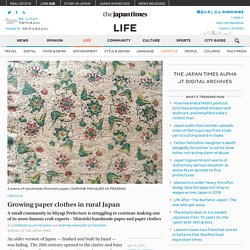
The 20th century opened to the clatter and buzz of machines, as the nation was swept toward an age of steel, standardization and skyscrapers. The call to modernity came like a shout from the Western world — Industrialize! — and it echoed through the streets of Japan’s expanding cities. But beyond the hinterland, the echoes quickly faded. Fumiko Sato was born into this mechanizing landscape in rural Fukushima Prefecture in 1939. Kamiko / Japanese Paper Clothes with Daphne Mohajer va Pesaran — EFA Project Space. Niponica NO.18. North American Supplier of Kakishibu and Related Goods. Recycler à l'époque Edo : des artisans au service de l'environnement - Artisanat Japonais. Le recyclage.
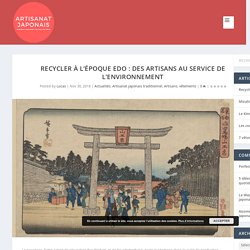
Cette action de récupérer des déchets et de les réintroduire, après traitement, dans le cycle de production, est une activité clé pour construire un futur meilleur à notre descendance. Et pourtant, à en juger par la taille des continents de plastique qui flotte dans le Pacifique (trois fois la France continentale !) , on a encore beaucoup à apprendre en la matière… Il est clair que l’un des plus grands fléaux de notre mode de vie, c’est que le système entier n’a jamais pensé jusqu’au bout les choses : que faire une fois un produit consommé ? Plutôt qu’un système en ligne droite (produire, vendre, acheter, consommer, jeter), il serait grand temps d’adopter dans n’importe quelle industrie possible un système cyclique (produire, vendre, acheter, consommer, recycler, reproduire, etc). Il suffit de s’inspirer des sociétés pré-industriels pour se donner des idées. . « Settanaoshi Chôgorô » par l’artiste Utagawa Kunisada Recyclage du papier ©juliaritson.com Le Washi.
今様職人尽歌合 SOURCES : Découvrez cette nouvelle collection de vêtements mêlant tradition et modernité ! Difficile de résister à cette nouvelle collection de vêtements mêlant tradition et modernité !

Découvrez cette nouvelle collection de vêtements mêlant tradition et modernité ! Le washi, ce papier japonais reconnu au patrimoine culturel immatériel de l'Unesco. Trois variétés de papier japonais ont été enregistrées comme patrimoine culturel immatériel.
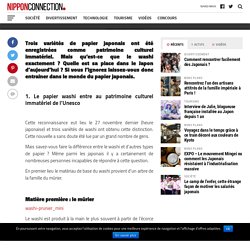
Japanese stencil dyeing : paste-resist techniques / by Eisha Nakano, with Barbara B. Stephan. - Version details. Katazome. Katazome is a traditional Japanese stencil technique for dying fabric and paper.

A rice paste is pushed through the open areas of a stencil, thus creating a resist during the later painting or dying process with fabric. In case of dying paper, ink is painted through the stencil's open areas directly. The following report is based on my experience with this technique during a class at the studio of John Marshall in Covelo, USA, in the Summer of 2010. A stencil. In earlier days, stencils were made from two layers of water-proof mulberry-paper. Cutting a stencil Preparing the resist paste: rice brane, komon nuka, and rice flour are mixed with water and formed into balls. The paste is applied to the fabric with a wooden spatula.
The rice paste is printed onto the fabric and has to dry now. Dyes can be prepared by mixing pigments with soy milk. Katazome – Japanese stencil dyeing. Japanese Textile Workshops 日本のテキスタイル ワークショップ. Indigo Dye Camp: Fujino Japan — Jill Aiko Yee. Below is a Q+A about my 2016 trip to Japan, with a group of Otis fashion school grads, to study heritage indigo dye and textile design. This interview was done with Lizzy Okoro of Bunch Magazine in Los Angeles, and was originally intended as a story for their print edition.
Lizzy moved on from Bunch to co-found Here Now Us before the interview could go to print. 10 of us traveled to Tokyo, and took a train with our host and teacher Bryan Whitehead to his property an hour away in the countryside. The trip was organized by Otis professor Sumi Lee - a devoted student of Bryan's. It was an intimate trip of creative personalities, learning, and hand work. Q: What prompted your trip? L’indigo 2. Aujourd’hui je vais vous parler de Katazome, cette technique pour obtenir des motifs (en blanc) sur un fond de teinture à l’indigo (bleu). Living National Treasure - ImmortalGeisha. Living National Treasure - ImmortalGeisha.
Chiba Ayano - ImmortalGeisha. Chiba Ayano (1889-1980) was a traditional indigo dyer who grew her own indigo and hemp, wove the cloth on a manual loom, fermented her own dyes, and dyed the cloth by hand using traditional methods. She was designated a Living National Treasure in 1955 for her preservation of shōaizome, indigo dyeing. History At age 14 Chiba Ayano began weaving hemp cloth as taught by her mother and grandmother.
Her mother did all the indigo dyeing of the finished cloth until Chiba was 34, at which point she began to dye her own cloth. She lived her entire life in the Kawakura Valley, near Sendai, where she was born. Chiba's life was tied to the agricultural calendar and she performed the same tasks her mother and grandmother did at the same times of year. In August, she harvested the hemp crop. Chiba would weave the thread they spun on a manual loom, every day, starting at sunrise using the natural light. Relations. Chiba Ayano - ImmortalGeisha. Le pigment indigo (2/2) : ses utilisations dans le monde. KATAZOME RICE PASTE RESIST – Handmaker's Factory.
Les pochoirs japonais - Katagami - Le japonisme - LM carnets d'auteur et lectures. Les Katagami sont des pochoirs en papier utilisés lors de la teinture des kimonos et des étoffes, afin d'y imprimer des motifs décoratifs. Ces pochoirs, en tant qu'élément constitutif du japonisme, ont influencé les arts décoratifs en Europe dans la seconde moitié du XIXe siècle. "Katagami. 真木テキスタイルスタジオ.